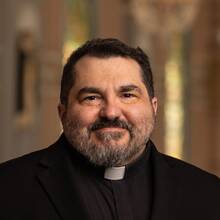On Earth as It Is in Heaven
Just as Christ was raised from the dead by the glory of the Father, we too might live in newness of life. (Rom 6:4)
Have you ever seen a love so pure that you caught a glimpse of God’s glory?
This Lent, how can you reveal God’s love to the world?
Without some background, the Transfiguration can be a difficult text to understand. It relies on religious ideas that were common in the first century but have since faded away. One notion that many ancient peoples shared was that gods “glowed.” Deities were refulgent with light and energy. Israel’s neighbors drew this idea from their experience of the sun and the stars, which they believed to be the visible forms of heavenly beings. In Israel, this idea came from the belief that God’s visible form contained elements of a thunderstorm, including clouds and a fiery, blinding radiance like lightning. These storm features made God’s presence visible, and collectively they were called the kabod or “divine glory.” This divine glory reflects off Moses’ face and draws Elijah up to heaven. Behind today’s Gospel is the belief that God had shared this divine glory with the Son of Man, who was coming to Earth to liberate Israel (Dn 7:14).
Also behind today’s Gospel is the belief that mountain peaks lie on the border of heaven and earth. On high mountains, God can reveal in visions what the world looks like from a heavenly perspective. Today’s Gospel records such a vision. Several motifs reveal that although Jesus and the apostles had not left the ground, they had entered a place more like the heavens. They saw a light as brilliant as the sun, they were covered by a cloud, and they encountered two men, Moses and Elijah, who many believed had been transported directly to the divine realm at the end of their lives. On this mountain God showed Peter, James and John what Jesus looks like in heaven: the Son bears the Father’s refulgent divine glory.
One could be forgiven for wondering why we read this in Lent; the Transfiguration seems more at home in the Easter season. The way things look in heaven, however, is not how they appear on earth. The divine energy that in heaven makes Jesus glow appears on earth as divine love. As Jesus will show, divine love entails a commitment to the service of others even in the face of death. This is not human glory, which usually involves greed and ego and pride. What looks like divine glory in heaven is the same force that led Jesus to give up everything on the cross.
All Christians are called to reflect Christ’s transfigured glory. The rite of baptism celebrated at the Easter vigil, for which Lent is preparing us, alludes to this: “You have been enlightened by Christ. Walk always as children of the light.” The light we pray for is the same as the love we learn in discipleship. Few Christians are called to reflect Christ’s glory in a death like his, although we know that this is still a possibility. All Christians, however, are called to reveal a love like Christ’s that gives up everything in service to our brothers and sisters, no matter the consequences. Glory in heaven might look like sacrifice on earth, but behind it all is the love that God offers us and dreams for us to share with each other.
This article also appeared in print, under the headline “On Earth as It Is in Heaven,” in the March 6, 2017, issue.









